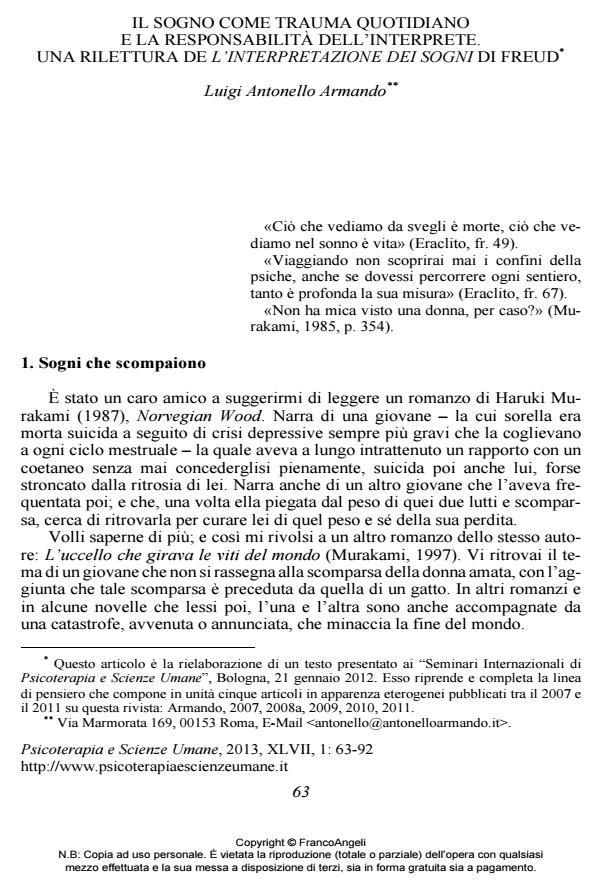Il sogno come trauma quotidiano e la responsabilità dell’interprete. Una rilettura de l’interpretazione dei sogni di Freud
Titolo Rivista PSICOTERAPIA E SCIENZE UMANE
Autori/Curatori Luigi Antonello Armando
Anno di pubblicazione 2013 Fascicolo 2013/1
Lingua Italiano Numero pagine 30 P. 63-92 Dimensione file 259 KB
DOI 10.3280/PU2013-001005
Il DOI è il codice a barre della proprietà intellettuale: per saperne di più
clicca qui
Qui sotto puoi vedere in anteprima la prima pagina di questo articolo.
Se questo articolo ti interessa, lo puoi acquistare (e scaricare in formato pdf) seguendo le facili indicazioni per acquistare il download credit. Acquista Download Credits per scaricare questo Articolo in formato PDF

FrancoAngeli è membro della Publishers International Linking Association, Inc (PILA)associazione indipendente e non profit per facilitare (attraverso i servizi tecnologici implementati da CrossRef.org) l’accesso degli studiosi ai contenuti digitali nelle pubblicazioni professionali e scientifiche
A L’interpretazione dei sogni di Freud (1899) viene attribuito il merito di avere ridestato l’interesse per i sogni in quanto espressioni della realtà psichica e via regia alla sua conoscenza. Più di cento anni dopo, un romanziere giapponese (Haruki Murakami) prospetta il rischio di una scomparsa dei sogni che porta con sé quella della realtà psichica e del mondo umano. In questo articolo l’Autore si interroga sulla realtà di tale rischio. A tal fine rilegge il testo di Freud del 1899 - che sembra offrire la maggior garanzia contro di esso - storicizzandolo, ovvero cercando di definire il posto che occupa nella storia dell’interesse per i sogni e nella storia personale di Freud. Conclude che, contrariamente all’apparenza, proprio quel testo avvicina il rischio prospettato dal romanziere giapponese; lo porta anche a sostenere che la responsabilità di evitarlo dalla quale è investito l’interprete assume oggi la forma di una separazione da quel testo e in generale dal riconoscimento della realtà storica di Freud e dallo stabilimento di un esatto rapporto con essa.
Parole chiave:Sogno, nuovo, realtà psichica, realtà storicadi Freud, responsabilità dell’interprete
Luigi Antonello Armando, Il sogno come trauma quotidiano e la responsabilità dell’interprete. Una rilettura de l’interpretazione dei sogni di Freud in "PSICOTERAPIA E SCIENZE UMANE" 1/2013, pp 63-92, DOI: 10.3280/PU2013-001005